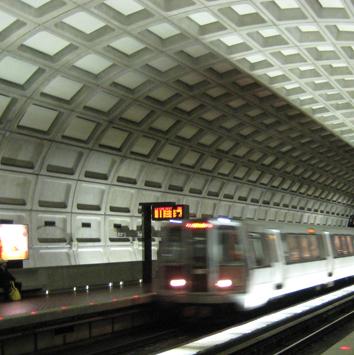An update to this story appears at the bottom of this article.
A landmark transit ridership model developed by the University of Maryland’s National Center for Smart Growth (NCSG) suggests that the location of job and households, the level of transit service, the cost of travel by different modes and the level of transit fares all fundamentally shape the demand for ridership on Washington’s Metrorail system, Metro. Shared recently with Washington Metro Area Transit Authority (WMATA) administrators and staff, the Origin-Destination Land Use Ridership Model (OD-LURM), helps inform the nature of rail ridership trends for Metro in the Washington metropolitan area.
The model, developed by NCSG researchers Dr. Hiro Iseki, Dr. Chao Liu and Dr. Gerrit Knaap and based on anonymized data detailing trips between nearly 7,000 origin and destination station pairs, confirms the importance of transit-oriented development in generating Metro ridership. The teams’ findings show that a 10 percent increase in households located within a half-mile walk of a station area increases transit boardings by 2.7 percent during the morning peak; similarly, a 10 percent increase in jobs located within a half-mile walk of a station area was found to increase transit alightings by 8.8 percent in the morning peak. The study also found that stations with more parking and better bus connectivity also had more ridership in both the morning and afternoon peak.
“While Metro doesn’t have authority in land use planning in the region, this study points to the critical role that jurisdictions can and should play in creating supportive land use patterns to improve the performance of Metro,” said Gerrit Knaap, who also directs the NCSG.
Service frequency, the cost of alternative modes of travel (including driving) and fares were also found to affect transit ridership. In particular, the study shows that fare “elasticity,” or the change of ridership demand in response to transit fares, varies substantially by travel distance. Short distance trips, for which there are many alternatives to Metro—including walking, biking, taxis, Uber and other car sharing options—tend to be more sensitive to fares. However, trips longer than six miles, where alternatives are limited to driving or buses, are less sensitive to fares. “As long as the majority of households remain in the suburbs and jobs are concentrated in the city,” the study explains, “the demand for long distance ridership on Metro will remain strong and relatively resistant to fare changes.”
“Because of the vast amount of high-quality data maintained by Metro, we were able to explore the relationship between transit ridership, transit fares and development patterns in new and powerful ways,” said Dr. Chao Liu. “We believe our model can provide decision makers with timely and data-driven information from which they can make difficult decisions.”
The authors suggest that these findings, “provide data to substantiate the claims that transit-oriented development and supportive land planning are powerful tools to sustain and increase Metrorail ridership, as well as [provide] a first glimpse at the role that low gas prices and the proliferation of travel options—such as walking, biking and ride-hailing services—have on the competitive landscape for trips.” They emphasize that sensitivity to fares will likely increase as alternative modes of travel, such as telecommuting, bike sharing, car sharing and autonomous vehicles become more readily available.
“Our study implies that in order to maintain robust ridership numbers, WMATA must make sure to connect sound pricing policies with improvements in rider experience with service quality, connectivity and response to the needs of its riders,” said Dr. Hiro Iseki. “Of course, all of this is contingent upon transit-supportive land use planning, without which Metrorail ridership growth could be constrained.”
Located at the University of Maryland, College Park, the National Center for Smart Growth is a non-partisan center for research and leadership training on smart growth and related land use issues in Maryland, in metropolitan regions around the nation and in Asia and Europe. The mission of the center is to bring the diverse resources of the University of Maryland and a network of national experts to bear on issues related to land use and the environment, transportation and public health, housing and community development and international urban development. Access the study here. To learn more about work and research done by the NCSG, visit their website.
Update Fall 2018
Following up on this 2015 WMATA-commissioned research project, researchers Hiroyuki Iseki, Chao Liu and Gerrit Knapp published a new article in the October 2018 edition of Transportation Research Part A: Policy and Practice, exploring the effects fares, train service, station parking lots, amongst other factors, have on transit ridership. The implications of this study, however, extend far beyond just the Washington, D.C., metro region. Using the information found in this study, transit agencies across the country can forge more efficient public transportation systems and push for more effective land-use practices that take into consideration the realities of the local built environment.
Of particular interest to transit planners was the authors’ discovery that the physical proximity of places of work to stations has a greater influence on public transit ridership levels than the proximity of homes. So, while the geographic relation of residential areas and transit stations should still be taken into consideration, planners and agencies must put a greater focus on systems that support business districts. The authors also suggest that local stakeholders improve the ability of residents to better access stations through enhanced street connectivity. In addition, making greater efforts to weave in other modes of transportation—including bus service, park-and-ride lots and ride-hailing services—would only enhance overall transit ridership totals.
Read the article “The determinants of travel demand between rail stations: A direct transit demand model using multilevel analysis for the Washington D.C. Metrorail system” here.

